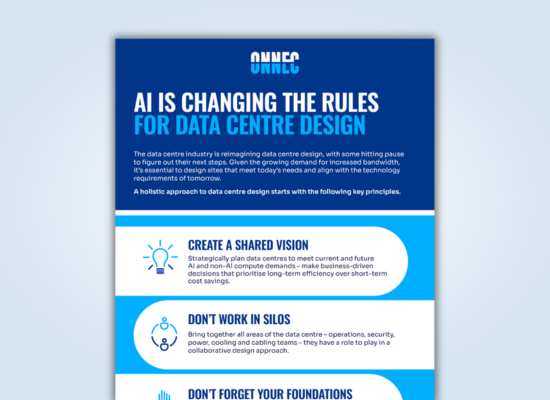
Future-proofing Data Centres: Cabling & Connectivity In The Age Of AI
In a rapidly advancing technological era, designing and developing data centres is pivotal to sustaining the digital world’s insatiable demand for data processing and storage. This includes not just the hardware that processes millions of bytes every second, but also the infrastructure that houses and supports it. But despite the critical role data centres play, certain aspects of design are often overlooked, leading to challenges that can impede future growth and efficiency.
The connectivity conundrum
Traditionally, data centre design has focused heavily on power and cooling systems, due to modern computing’s immense energy requirements and heat generation. This focus can sideline other crucial elements, such as cabling infrastructure – a fundamental yet frequently underestimated part of data centre design. This oversight can lead to serious operational challenges in the future.
Amid rapidly evolving business technologies, especially AI tools, some data centre operators cut corners to reduce costs. But here, short-term savings often lead to long-term expenses and operational challenges. Design decisions in data centres should not be made in isolation but must consider the integrated impact on the entire business landscape. Once operational, altering some design aspects becomes not only costly but often impossible, potentially resulting in persistent issues such as frequent downtime and limited scalability. Recognising and planning for these challenges is crucial for future-proofing data centres.
As we move further into an era dominated by AI and machine learning, data centre infrastructure is not just about efficiency but a strategic imperative for sustainable growth.
Cutting cabling corners
Cabling, much like the nervous system in the human body, is essential for the seamless operation and communication within data centres. Neglecting it during the design phase can result in tangled, disorganised connections that not only hinder current operations but also complicate future upgrades. This often necessitates a complete overhaul, leading to additional costs and unwanted downtime. Choosing lower-quality cabling can be counterproductive, increasing the time and cost of troubleshooting and necessitating early replacements.
For both new and upgraded data centres, investing in high-quality cabling is key. This investment futureproofs operations for emerging technologies such as AI, ensuring long-term cost savings, minimising downtime, and maintaining operational flexibility. Prioritising design and investing in high-quality components from the outset is essential to adapt to unknown future hardware requirements and acts as a safeguard against frequent downtime and scalability challenges.
AI in data centre design
AI applications are revolutionising data centre designs, necessitating infrastructure tailored to the unique needs of machine learning algorithms. To keep pace with global investments in AI, data centres must evolve in three key areas.
Firstly, there is a significant increase in power requirements, as AI computers rely heavily on specialised processors like GPUs and DPUs – which consume more power and generate more heat than traditional CPUs. Secondly, robust power infrastructure and efficient cooling solutions, like liquid cooling, are imperative to handle the increased load. Finally, cabling – often the ‘forgotten child’ of design – is also habitually overlooked and under-budgeted. These embedded infrastructure elements can be extremely costly to replace if not appropriately planned, leading to significant operational challenges.
Future-proofing data centres
Data centres are constantly evolving, which requires foresight and strategic planning. Investing in high-quality infrastructure from the beginning is not just a technical necessity; it’s a strategic decision that determines the long-term viability and growth potential of data centres.
As we move further into an AI-driven future, this comprehensive approach to data centre design becomes not just beneficial, but essential, for staying ahead in a rapidly advancing technological landscape.
From an article in Networks Europe Magazine published on December 2023. Read the full Issue here.
About Networks Europe Magazine
Networks Europe Magazine is owned by Abacus Communications who is an independent events, publishing and association management group providing integrated information, knowledge and networking products to selected B2B markets.
www.networkseuropemagazine.com



